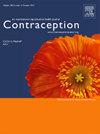Contraception and nonalcoholic fatty liver disease in women with prior gestational diabetes mellitus
IF 2.3
2区 医学
Q1 OBSTETRICS & GYNECOLOGY
引用次数: 0
Abstract
Objectives
Nonalcoholic fatty liver disease (NAFLD) is an increasing concern among women with a history of gestational diabetes mellitus (GDM). Hormonal contraceptives may affect liver metabolism, potentially increasing NAFLD risk. This study examined the association between different contraceptive methods and NAFLD risk approximately one year postpartum in women with prior GDM.
Study design
We conducted a prospective cohort study involving 130 women with prior GDM. We categorized these women into three groups based on their contraceptive use: no contraception or non-hormonal methods (n = 86); progestin-only contraceptives (POCs), including progestin-only pills (POPs), depot medroxyprogesterone acetate (DMPA), and implants (n = 29); and combined oral contraceptives (COCs) (n = 15). At 1 year postpartum, we measured the controlled attenuation parameter to assess hepatic steatosis and diagnose NAFLD. We used multivariable logistic regression analyses to evaluate the association between contraceptive methods and NAFLD risk.
Results
The POC group had the highest median controlled attenuation parameter (307 dB/m) and NAFLD prevalence (55.2%), followed by the no contraception or non-hormonal group (237 dB/m; 30.2%), with the lowest values in the COC group (213 dB/m; 13.3%). POCs, particularly POPs and DMPA, significantly increased the risk of NAFLD compared to no contraception or non-hormonal methods (adjusted odds ratio 4.28, 95% confidence interval 1.55–11.85). In contrast, COCs did not show a significant association with NAFLD risk.
Conclusions
POCs, particularly POPs and DMPA, significantly increased NAFLD risk, whereas COCs showed no such association. These findings have important implications for contraceptive counseling in women with prior GDM.
Implications
Healthcare providers should be cautious about the increased nonalcoholic fatty liver disease risk associated with progestin-only contraceptives, especially progestin-only pills and depot medroxyprogesterone acetate. These findings could guide contraceptive options for women with a history of gestational diabetes mellitus.
妊娠期糖尿病妇女的避孕与非酒精性脂肪性肝病
目的:非酒精性脂肪性肝病(NAFLD)在有妊娠糖尿病(GDM)病史的女性中越来越受到关注。激素避孕药可能影响肝脏代谢,潜在地增加NAFLD的风险。本研究调查了患有GDM的妇女产后大约一年不同避孕方法与NAFLD风险之间的关系。研究设计:我们进行了一项前瞻性队列研究,涉及130名既往患有GDM的女性。我们根据她们的避孕方法将这些妇女分为三组:没有避孕或非激素方法(n = 86);纯孕激素避孕药(POCs),包括纯孕激素药丸(pop)、醋酸甲孕酮(DMPA)和植入物(n = 29);联合口服避孕药(COCs) (n = 15)。在产后一年,我们测量控制衰减参数来评估肝脂肪变性和诊断NAFLD。我们使用多变量逻辑回归分析来评估避孕方法与NAFLD风险之间的关系。结果:POC组控制衰减参数中位数最高(307 dB/m), NAFLD患病率最高(55.2%),其次为无避孕或无激素组(237 dB/m);30.2%), COC组最低(213 dB/m;13.3%)。与不避孕或非激素方法相比,POCs,特别是持久性有机污染物和DMPA显著增加NAFLD的风险(调整优势比4.28,95%置信区间1.55-11.85)。相比之下,COCs与NAFLD风险没有显着关联。结论:POCs,特别是POPs和DMPA,显著增加NAFLD风险,而COCs则没有这种关联。这些发现对既往GDM妇女的避孕咨询具有重要意义。
本文章由计算机程序翻译,如有差异,请以英文原文为准。
求助全文
约1分钟内获得全文
求助全文
来源期刊

Contraception
医学-妇产科学
CiteScore
4.70
自引率
17.20%
发文量
211
审稿时长
69 days
期刊介绍:
Contraception has an open access mirror journal Contraception: X, sharing the same aims and scope, editorial team, submission system and rigorous peer review.
The journal Contraception wishes to advance reproductive health through the rapid publication of the best and most interesting new scholarship regarding contraception and related fields such as abortion. The journal welcomes manuscripts from investigators working in the laboratory, clinical and social sciences, as well as public health and health professions education.
 求助内容:
求助内容: 应助结果提醒方式:
应助结果提醒方式:


